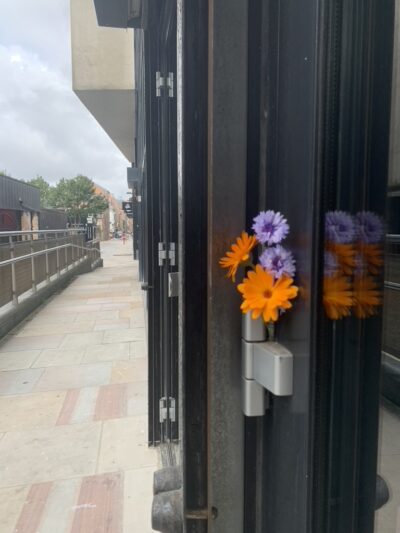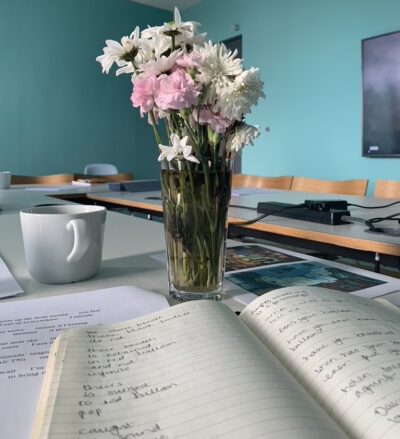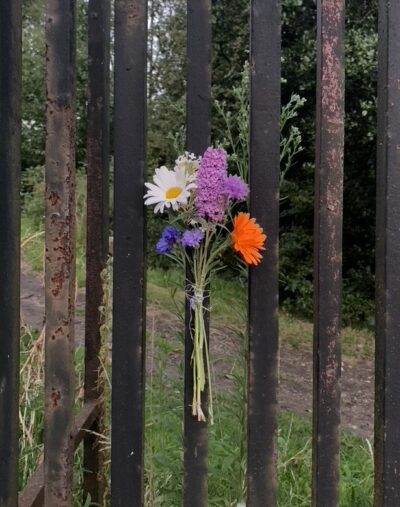Day Mattar was our 2023 Liverpool Writer In Residence–bringing the residency to the writer, and letting them make it best fit the place and their ideas. Their residency at FACT Gallery included readings, workshops, and on-site interaction. They also held workshops at GYRO, and wrote a new poem for the CF Writers’ Award anthology.

I chose FACT Art Gallery as a base for my residency because I’ve often sought refuge there, (from rain, heartache, work) and trusted it to shelter part of my creative self that was spent from the process of writing a poetry pamphlet about CSA trauma. So for two months I spent every Thursday in FACT, with no plan, simply a body in a space, comforted by the company of art.
Neon tubes, manipulated to say ‘BIZZARE’, glowing above a door, welcomed me to Gallery Two, where I’d decided to settle, amongst the works of Chila Kumari Singh Burman, Kerolaina Linkeviča and GLOR1A. Humanoid projections. 3D sculptures of alien DNA. LED cable lights wrapped around concrete columns. A neon tiger prowling the back wall. All this visual stimulation, and yet so much calm. As the UK’s leading organisation embracing new technology in art, FACT was already proving successful in stimulating new modes of thought within me, a lens with which to playfully warp and imagine the world.
At a hexagon table, in the back corner of the room, with all of this in mind, I set up camp each week. I felt a bit like an interstellar traveller visiting a new planet. I wrote the following intentions:
find language that acts as torchlight,
find a guide from the vacuous dark of oneself to another,
find a soul-to-soul language.
the body language is that of the soul,
the spoken language is that of the body,
the written language is that of the mind,
the mind language is not trustworthy.
find a faithful language,
find a common language.

I understand (after everything) that poetry, alone, is not a substitute for therapy, and certainly not a substitute for real life. I have an idea, though, that when coupled with somatic practise (rituals engaging the body) poetry may genuinely affect the mind (where the ‘real’ world is interpreted).
Surrounded by soulful tech, I began to consider the hardware & software of the psyche, to think of habits and traits as codes, of languages as formulas, of the natural world as data. With human morality stripped back to digits, usually tricky and complex issues like homophobia and racism began to shift, appearing simply as faulty software that (while seemingly ingrained) may be rectified by sufficient spyware–something installed can be uninstalled.
A few months before my residency, I developed a tic which manifested as loud gasps and sharp neck spasms. These were usually triggered by intrusive thoughts, or moments where I caught myself drifting off when I ought to be concentrating, sometimes at the cinema, or during conversation (very embarrassing). These futuristic art works helped me reframe my ticks and obsessive thoughts as glitches, which might be re-written (not without hard work) over time.
In a dark corner of the gallery, a figure, moving through ankle deep water, the way dead leaves swirl in a helix of wind. This body, swaying in my periphery, often caught me while was trying to pin down a thought and, distracted, it’d shoot off like a comet. In a room with such provocative concepts and imagery, I found myself drawn to the thing most simply relating to the human. Kerolaina Linkeviča, the creator of ‘PRIMORDIA’, and my muse, was inspired by research into Goddess/Goddexx worship. I knew nothing of this at the time, wanting my response to the art to be unfiltered, but weekly began to deify the character dancing before me:
‘trapped in this room for a week she would become my friend, that is my nature, in a month she would become my muse, that is my nature, to take admiration and coax beauty, after a year she would become my god and I would adhere by every wrist flick and whim, in ten years she would become my parent, and I would begin to hate her. I would avoid eye contact even though she has none. If twenty years, if my whole life, she would eventually become me, and we would live happily-unhappy together, in symbiosis.’
A series of drafts began to form as my relationship with the goddess developed, though not explicitly about her, she became a kind of looking glass, taunt, and sounding board for them:
She implores me that I have spent too much time talking.
Her ass is two halves of chopped melon.
She spins and shows me how to dance out of grief.
I asked myself the following questions:
Where would she be without human interaction to maintain her?
Where would I be without human interaction to maintain me?
How many people has she touched?
How many have I?
Is she doomed to repeat the same dance?
Am I doomed to repeat the same dance?

The qualities of the real and the synthetic were beginning to blend. If what makes us ‘real’ is our biology, then how does a person with a prosthetic limb relate to their prostheses? How do we relate to our devices? Where would we be without them? Where would they be (where might they go…) without us? In this new vision of the world, repeated, unhealthy behaviours and thought patterns cannot not hide away as traits or compulsions we are helpless to–we must admit we can change them, which a line in ‘flower code’ declares:
‘I am
who I am
because I’m too lazy to be who I want to be.’
This residency came after a period of disconnect from my poetry practise. I’d spent the last ten years lowering into the serious subject of my pamphlet, springing from the pews, utilising a serious craft, seriously, and (no wonder!) after it was all done, ended up suffering creative fatigue. I journeyed as far down into that well as I could, and scrambling back up, abandoned the tools that guided me whilst down there. I saw this opportunity as an invitation to hoist my poems back up from where I’d left them. I’m grateful to Creative Future for encouraging me to go back and for having faith that I’d return with something worthwhile.